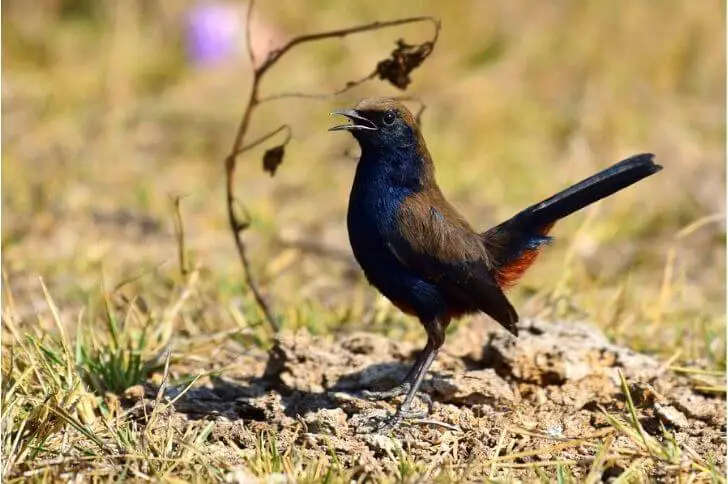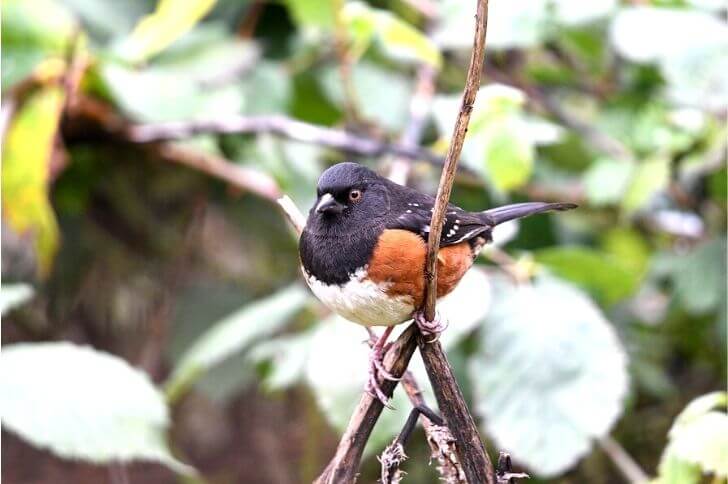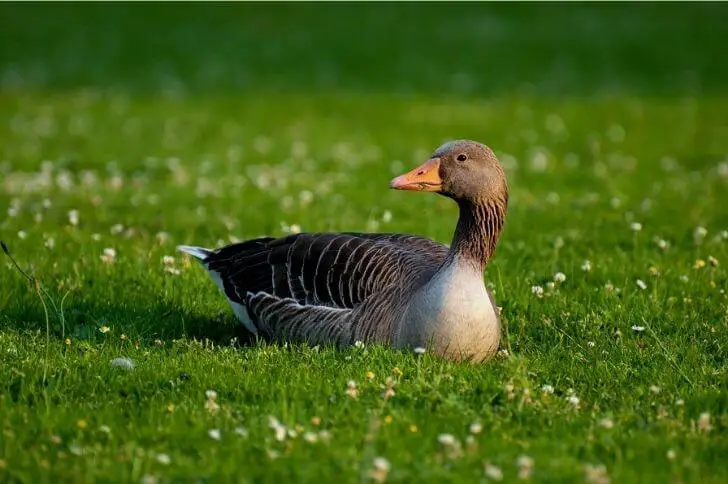There are many birds that start with I. From the ibis in North America to the izu thrush of Japan, there is plenty to learn from this list.
Below we’ll describe the different characteristics of these birds with letter i including their habitats, breeding and more. If you are a birder, there are plenty of birds I recommend you add to your watch list. Let’s get started.
List of birds that start with i
1. Ibisbill
The ibisbill is a waterbird that is found in the rivers and streams of Asia. Related to other water birds like gulls and terns, it has a long, curved bill which is used to probe for food in the mud at the bottom of rivers and streams.
It feeds on small fish, aquatic insects, and crustaceans. The breeding season begins in May, and during this time the male ibisbill builds a nest out of reeds on the riverbank.
The female lays three or four eggs, and both parents help to incubate them. The chicks hatch and are fed by both parents until they are able to fledge at around six weeks old.
2. Imitator goshawk
The imitator goshawk is a raptor that inhabits montane forests. This hawk is named for its ability to mimic other birds’ calls.
This medium-sized hawk has black plumage on its upperparts and white on its chest. It has a long, hooked beak and sharp talons. This hawk feeds on small mammals, reptiles, and birds. The imitator goshawk is a solitary bird that typically nests in trees.
3. Iphis monarch
Another small bird that starts with i is the Iphis monarch or pomarea iphis. Commonly found in shrubland, this bird is sexual dimophic. The female features brown upperparts and pale underparts while the male has bluish-black plumage.
Iphis monarchs’s diet mainly consists of insects and these birds are monogamous.
4. Ivory gull
The ivory gull is a small white bird that begins with letter i. Widely found in the arctic and subarctic regions, it is the smallest of the arctic gulls.
The ivory gull breeds on the pack ice and spends most of its time in the water. Chicks fledge at about four weeks old. This i bird feeds mainly on fish, but also eats insects and other small animals.
5. Inca jay
Looking for a colorful bird beginning with i? The Inca jay was thought to be part of the green jays but in 2009, a decision was made to split this into its own jay species.
With calls that sound like an alarm bell, the inca jay is a striking blue and black bird that is found in the highlands of Peru and Ecuador.
This small jay is shy and retiring, preferring to stay hidden in the undergrowth. The Inca jay is one of the few birds that can eat the seeds of the coca plant without getting sick.
These birds are also known for their intelligence and ability to learn new tasks quickly. In captivity, Inca jays have been known to use tools to get food out of cages.
Related: List of birds that start with h
6. Indigo flycatcher
The Indigo flycatcher is a small, but striking bird that can be found in parts of the US. This passerine bird is mainly blue and black, with a white belly and a long tail.
The female and male share similar features. The indigo flycatcher eats insects, and can often be seen hovering or perching near water. Indigo flycatchers are migratory, moving to warmer regions during winter.
They build their nests out of twigs and other materials in trees or shrubs, and lay 3-6 eggs. These birds are not common, but are easy to identify due to their bright colors.
7. Ivory-billed woodcreeper
If you ever go for excursions to lowland forests in Mexico, Belize or Costa Rica, chances are you’ll come across the Ivory-billed woodcreeper. Do not confuse this bird with the Ivory-billed woodpecker.
This woodcreeper is around 9 inches long and has a pale bill and streaked body. It is a shy bird and lives in trees, feeding mainly on insects. They are very good climbers and can move quickly through the trees. They build their nests in tree cavities or on branches.
8. Iberian green woodpecker
Another group of birds that start with i are the Iberian green woodpeckers. It is a medium-sized, slender woodpecker found in garden lawns across Europe.
It has a green back, white underparts, and a red cap. The Iberian green woodpecker feeds on insects, which it extracts from tree bark using its long, sharp beak. It breeds in open woodland areas, making a nest hole in a tree trunk. You can learn about other woodpeckers here.
9. Inca tern
Black, bold and simply gorgeous. Inca terns are a species of seabird that are found in coastal areas of South America.
They are a fairly common sight, and can be identified by their black and white coloring and long, thin wings.
Inca terns feed on small fish, which they catch by plunge-diving into the water. They are monogamous birds, and both parents take part in raising their young. Inca tern chicks are able to swim and dive soon after they hatch, and can often be seen following their parents around while they forage for food.
10. Indochinese roller
The Indochinese roller is one of the coolest birds in the world. This Migratory bird that can be found in parts of Southeast Asia. It is a member of the roller family, which includes birds such as the European roller and the American roller.
The Indochinese roller is a medium-sized bird, with a length of about 18 inches. It has a long tail and brightly colored wings. The male and female are both bluish and greenish, with a lilac colored throat. The bird feeds on insects, which it captures by flying down to the ground to catch them.
11. Island whistler
Island whistler is the common name for the endemic songbird. Its scientific name is Pachycephala phaionota. This bird species is found in the tropical Pacific Islands. It is a smaller slender in size compared to the Indochinese roller that we looked at earlier.
This small bird also has a long tail, predominantly dark brown plumage, and a white throat and breast.
This active bird feeds mainly on insects, but will also take fruit. It is a territorial species which sings duets with its mate to defend their territory. The island whistler builds a simple cup-shaped nest from twigs and grasses, which it typically places in a tree or shrub.
12. Indian robin
Found across India, the Indian robin can be found in scrub forests or rocky habitats.
This passerine bird is also a common resident of gardens and parks, having learnt to live around people due to habitat loss. It is a terrestrial bird and typically feeds on the ground, where it forages for insects and will also feed their young ones with small amphibians.
It is a timid species and often hides when threatened. The Indian robin builds a cup-shaped nest out of grasses and lays two or three eggs which take about 12 days to hatch.
13. Inland thornbill
Another passeriene that start with i is the inland thornbill. I believe it’s important for every birder to plan a bird watching tour to Australia. This country has plenty of birds to see including the inland thornbill.
It is a small, brown bird that can be found in the Australian Outback. This bird is a member of the acanthizidae family which has 67 members including whitefaces and hearthwrens.
The bird has a small bill that feeds on insects and spiders, which it extracts from tree branches and crevices. This bird can also be seen drinking nectar from flowers. The Inland thornbill builds its nest out of twigs and grasses, and lays two to four eggs.
14. Icterine warbler
The icterine warbler is a small passerine bird that is found in open woodlands and gardens. It is the most widespread member of the icterine warbler complex, a group of closely related birds that are mostly yellow with hints of gray
The icterine warbler has a streaked brown back, yellow underparts, and a short sharp .The female lays four to six eggs, which are incubated for 12–13 days by the female alone.
15. Indigo bunting
Cardinals are some of the most common birds in the Us. The indigo bunting is part of the cardinal family. The sexes have different plumage.
The male is a beautiful blue color, while the female is a muted brown. They are usually found in open areas near trees, where they can hop around on the ground looking for food. Indigo buntings eat insects and seeds.
These birds are very territorial and will often sing to let other birds know that this area is taken. The indigo bunting’s song is a cheerful series of high-pitched notes that sound like “pee-a-wee.” They are most active during the day, but can sometimes be seen feeding at dusk or dawn.
16. Indian blackbird
The Indian blackbird is small beautiful bird that has a noticeable orange tear-drop shaped patch around its eyes that matches its orange bill.
This passerine bird was thought to be part of the blackbird family but after some research this was changed and it was added to the thrush family.
This blackbird is sexually dimorphic, both are black but the male has a darker shade of black on its head (capped). The Indian blackbird is a songbird and sings a variety of songs, including harsh notes, whistles, and mimicry.
17. Izu thrush
There are many songbirds in Japan. One of the most popular birds that start with i is the Izu thrush.
Both sexes have brown backs, white bellies. The only distinguishing feature between males and females is that males have a black hood.
Izu thrushes are known for their melodic songs, which can be heard throughout the islands. They feed on insects and spiders, as well as fruit and berries
. Izu thrushes form monogamous pairs and build nests out of twigs and mosses. The female lays 2-4 eggs, which are incubated for about two weeks.
18. Indian cuckoo
The Indian cuckoo is a medium-sized bird that is found in the forests of India and Southeast Asia. It is a member of the cuckoo family, and is known for its distinctive call.
The Indian cuckoo is a shy bird that lives mostly in trees, and feeds on insects and fruit. It lays its eggs in the nests of other birds, and the young cuckoos then push the other eggs out of the nest to hatch themselves.
19. Isabelline shrike
Another small bird that made it to our list of birds that start with i is the cute isabelline shrike.
It is mainly found in open country with bushes or trees. The is migratory, wintering in Africa. This shrike is a predator which feeds mainly on insects, but will also take rodents, lizards and other small vertebrates.
It has a strong hooked bill and hunts by perching on a bush and scanning the ground for prey. The male Isabelline Shrike is larger than the female, and has brighter plumage.
20. Indian vulture
Large and powerful the Indian vulture is a scavenging bird that is found in the Indian subcontinent.
These birds have a bald head and a reddish-brown body. They are around 41 inches long and have a wingspan of around 7.8 feet. These types of vultures are scavengers and feed on the carcasses of dead animals.
They play an important role in the ecosystem by removing the carcasses of dead animals from the environment. When it comes to breeding, this species starts at the age of five and there have been conscious efforts trying to increase their numbers.
21. Island monarch
The island monarch is a small bird that is usually less than 8 inches long. This bird has a gray back and brown – orange belly. They are very common in the wild and can often be seen perched high in the trees or flying through the air.
Island monarchs feed on insects and spiders, and they build their nests out of twigs and leaves. These birds are very territorial and will often fight with other birds to protect their territory. As a birder, you’ll love their captivating black eyes.
22. Island leaf warbler
The island leaf warbler is a small passerine bird that is found in the tropical and subtropical forests of the Indian Ocean islands. It is a member of the Old World Warbler family
The adult has a pale head, bright yellow upperparts, and black patches on the wings and tail.
The island leaf warbler feeds on insects which it gleans from foliage or catches in mid-air. They have stunning black eyes like the island monarchs.
23. Iago sparrow
Iago sparrows are one of the most common birds on the African continent. These small birds are very interesting because of their unique sparrow-like calls.
These passerines are sexually dimophic, and the only feature that differentiates the sexes is the male black cap.
These types of sparrows are very sociable. Breeding seasons last from August through November with pairs nesting alone. Eggs are incubated by both parents.
24. Imperial woodpecker
The Imperial woodpecker is a large, black and white woodpecker that is normaly recognizable because of its distinctive red crest males). Females have an all black crest.
They can be found in several parts of Mexico. This bird is the largest of its kind and can weigh up to two pounds and measure up to 23 inches long. The Imperial woodpecker has a long bill that it uses to eat insects, small animals, and fruit.
25. Iceland gull
Found only in Iceland, the Iceland gull is a small gull and is the smallest gull in Europe. This gull has a characteristic all white body with gray highlights on its wings. Also, some adults may have patches of black on their tails. The Iceland gull is found on rocky coasts and in narrow fiords where it feeds on small fish and crustaceans.
Most birders have likened its call to that of a herring gull but pitcher. These birds are known to migrate in winter.
26. Inca dove
Discovered in the 1800s, the inca dove is a small, white and gray bird that can be found in most of South America. These types of birds that start with i nest in shrubs and trees. The male finds the necessary materials while the female sets up the nest.
These birds are monogamous with the female laying up to 10 eggs each season. It takes up to 16 days to hatch. The dove is known for its beautiful vocalization, which includes cooing sounds.
27. Invisible rail bird
I think the invisible rail is the most interesting bird on this list of birds beginning with i. It’s very hard to spot this bird. It’s very elusive hence its name.The secretive harpy eagle is a large raptor whose habitat can be found across Indonesia.
These birds are incredibly agile and fast flyers, making them incredibly difficult to spot! This creature is well-known in conservation circles because of its importance to the environment
28. Italian sparrow
Cisalpine sparrow or the Italian sparrow is a small passerine bird that is found in Italy and parts of Europe. It is a common resident of urban areas and suburban neighborhoods.
This tree sparrow measures up to 6 inches long and produces a similar call to the house sparrow. Unlike other birds in our list, this bird is widely consumed in Italy.
29. Imeri warbling antbird
The Imeri warbling antbird is a passerine found in the Amazon region. It is a common resident breeder in the tropical moist lowlands, where it forages for insects and seeds.
This antbird is generally considered to be a robust and plesiomorphic species within its genus, with a relatively simple taxonomic structure. Despite its general lack of conspicuous features, this antbird is known for its vibrant song, which contains several distinctive notes.
30. Inagua woodstar
With its long beak and unique purple throat, the inagua woodstar is part of the hummingbirds family. This long-tailed hummingbird is found mainly in wooded habitats where it forages for food and builds nests. Long beak helps it when sucking nectar.
31. Indian cormorant
The Indian cormorant is a large seabird that ranges across much of the Indian and Pacific Oceans. It is sometimes considered a subspecies of the common cormorant but it has been given its own species classification by some taxonomists.
The Indian cormorant is one of the largest and most widespread cormorants in the world, with a wingspan up to 39 inches. It feeds on fish, crustaceans, and other aquatic invertebrates.
32. Indian white-eye
Gorgeous bright yellow plumage, white underparts and stunning eyes, the Indian white-eye is a common bird found in many parts of India.
This small bird starts breeding in February through September. The female lays bluish eggs that take up to 10 days to hatch. Indian white-eye feeds on small insects and spiders.
33. Intermediate egret
White and graceful, the intermediate egret is a mid-sized heron that can be found in fresh and shallow coastal waters.
This all-white bird has a long yellow bill that it uses to catch frogs, fish and more. It also has long legs that help it wade through the marshes. The Intermediate egret is a curious bird that often perches in trees to watch its surroundings.
Hi fellow bird watcher. Welcome to our small corner of the world. At the spanishbirdguides.com our mission is to share with other bird watchers the things we love about birds, where to go bird watching within the United States, and more. I’d also love to hear from you. Feel free to contact me about your bird watching escapades, share videos, photos and more.



